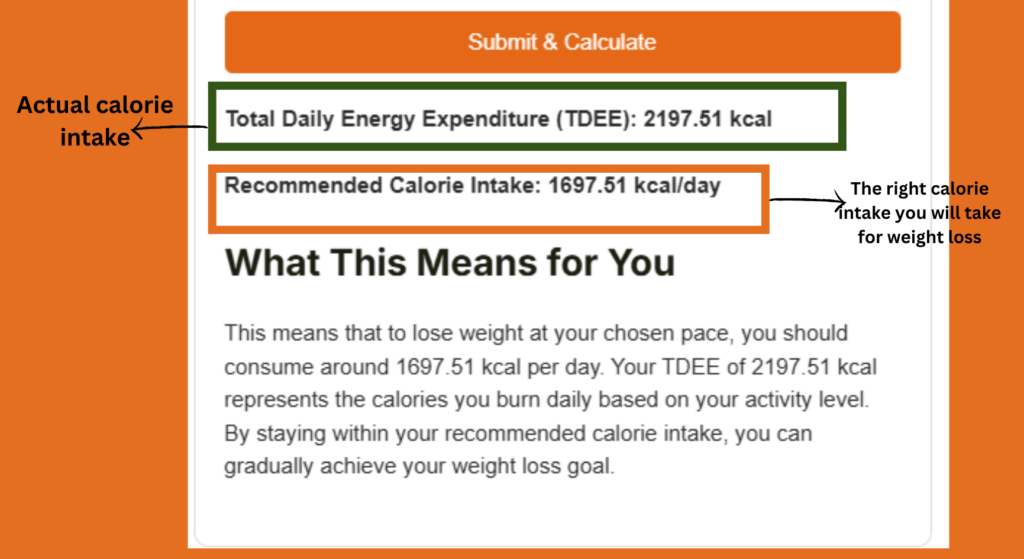
Time to go back to high school to learn mathematics, but I promise learning how to calculate calorie deficit for weight loss won’t be difficult.
This 1 formula will set you on a fast and sustainable way to lose your body fat.
First of all, calories are units of measure that show the amount of energy in foods and drinks. Hence, the body requires a certain number of calories to function.
But since the body is deceptive by nature, your body can accept x3 of the needed calorie intake. The excess will be stored as body fat.
Steps to Calculate Calorie Deficit for Weight Loss
A. Calculate Your Maintenance Calories
To lose weight, you need to create a calorie deficit – consuming fewer calories than your body burns. The first step is to determine your maintenance calories, which is the number of calories your body needs to maintain your current weight.
There are a few ways to estimate your maintenance calories:
- Use an online calculator: You can simply use the free online calorie calculator below to estimate your maintenance calories based on your age, gender, weight, height, and activity level.
Calorie Deficit Calculator
Enter Your Email to See Your Results
This online calculator is more accurate than the 2nd way; Harris-Benedict equation. But for curiosity sake, let’s look at the Harris -Benedict equation.
- Use the Harris-Benedict equation: This formula estimates your basal metabolic rate (BMR), which is the number of calories your body burns at rest.
You can then multiply your BMR by an activity factor to get your estimated maintenance calories.
BMR for men = 66.5 + (13.8 × weight in kg) + (5 × height in cm) – (6.8 × age in years)
BMR for women = 655.1 + (9.6 × weight in kg) + (1.9 × height in cm) – (4.7 × age in years)
Choose the activity factor that you belong to :
- Sedentary (little or no exercise): Multiply BMR by 1.2
- Lightly active (light exercise 1-3 days/week): Multiply BMR by 1.375
- Moderately active (moderate exercise 3-5 days/week): Multiply BMR by 1.55
- Very active (heavy exercise 6-7 days/week): Multiply BMR by 1.725
- Extremely active (very heavy exercise, physical job): Multiply BMR by 1.9
For example:
| A 26-year-old woman who weighs 58 kg, has an height average of 165 cm. Using the BMR formula for women:BMR = 655.1 + (9.6 × 58 kg) + (1.9 × 165 cm) – (4.7 × 26 years)BMR = 655.1 + 556.8 + 313.5 – 122.2BMR = 1,403 calories The activity level is moderate:Moderately active (moderate exercise 3-5 days/week): Multiply BMR by 1.55Maintenance calories = 1,403 x 1.55 = 2,175 calories per day |
B. Adjust your calorie intake for weight loss
Now you know the right amount of calories your body needs, it’s time to reset that amount by cutting off either; 250, 500 or 750 calories from your acutual calories number.
For example, my actual calorie my body needs is 2197kcal. But since I choose to deficit with 500 calories, I will have to eat only 1697kcal per day.

Although I am deficting on 500kals, it’s important to gradually increase the calories you cut off to avoid gaining weight on a calorie deficit. The simple reason is because you may enter a body plateau, and you won’t be able to lose weight again.
How much calorie deficit do I need to lose weight?
The general recommendation is to start with a moderate deficit of 500 calories per day. This is considered the “sweet spot” for sustainable fat loss.
Cutting 500 calories per day is the best approach, if you want to aviod having excess skin. It also important to note that when you drastically cut calories, your body can go into “starvation mode” and start to slow down your metabolism to conserve energy. A moderate deficit allows your metabolism to continue functioning optimally, without triggering this adaptive response.
Besides since cutting down calories from your diet, your body will still require basic nutritional needs from the foods you eat. Larger deficits can make it harder to get adequate protein, vitamins, minerals, and other essential nutrients.
Start by creating a 500-calorie deficit from your maintenance calories. This moderate deficit allows your body to adapt gradually and helps establish sustainable habits.
After about 3 months, if weight loss has slowed or plateaued, consider increasing your deficit to 750 calories per day. This slight increase can help reinvigorate your weight loss progress.
As you continue your weight loss journey, pay close attention to how your body responds. Once you’ve acclimated to the new deficit and are seeing consistent results, you can start alternating your calorie deficit to prevent metabolic adaptation.
The next step to consider is calorie cycling. Implement a cyclic approach to your calorie deficit once you’ve gotten your desired body. For example, after you’ve been on a calorie deficit plan for 6-12 months, you’ve entered a body platuead. Now you will have to trick your brain a little. So for the next month change to:
1st Month: 750-calorie deficit
2nd Month: 750-calorie deficit
3rd Month: 250-calorie deficit (only if your body has adapted well to previous deficits)
4th Month: 500- calorie deficit
This alternating strategy can help prevent your metabolism from adapting too much to a single calorie level, potentially making your weight loss more consistent over time.
Always listen to your body and adjust your approach based on how you feel, your energy levels, and your overall health. If you experience excessive fatigue, persistent hunger, or other negative symptoms, it may be wise to reduce your deficit or consult with a healthcare professional.






